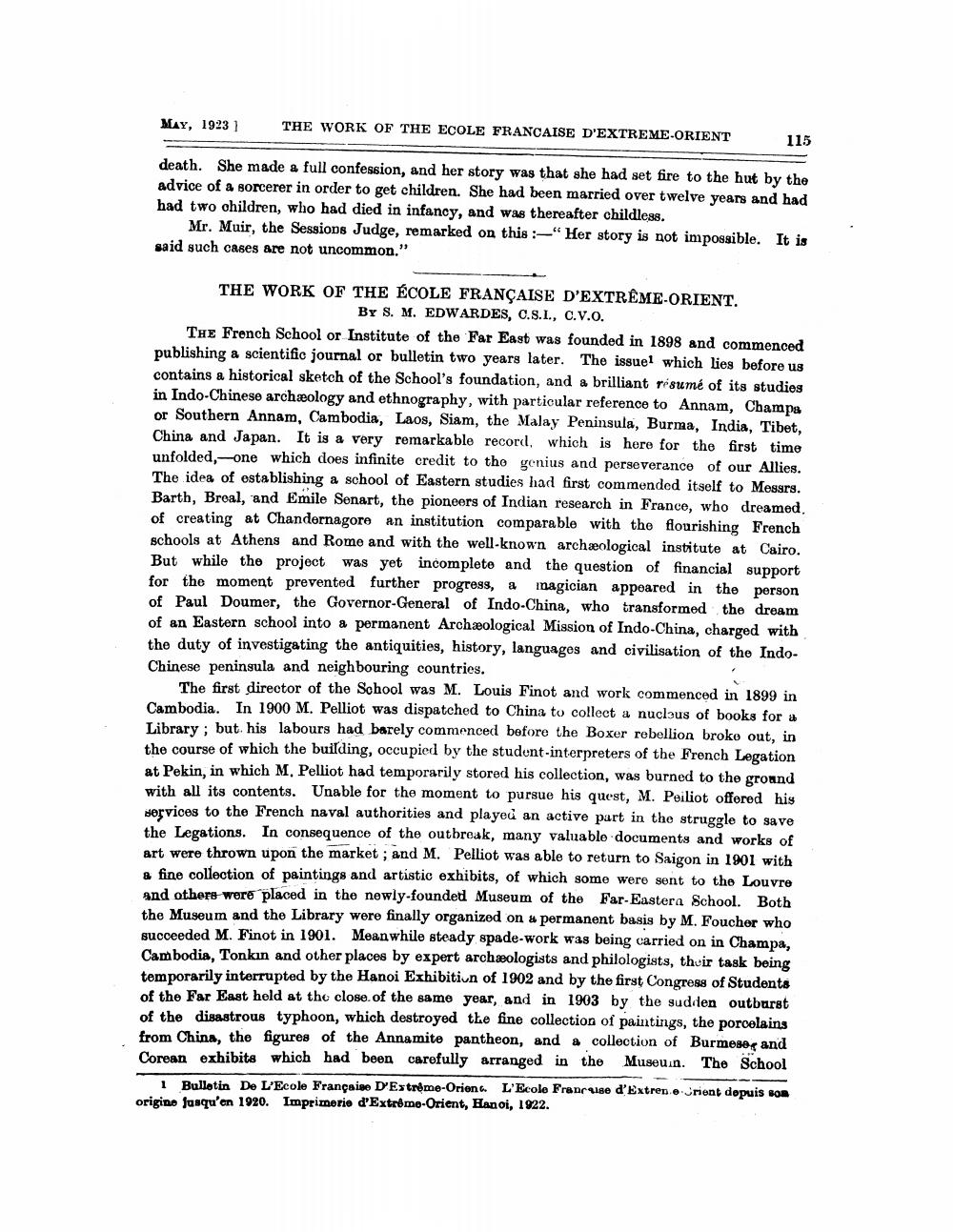________________
MAY, 1923 ]
THE WORK OF THE ECOLE FRANCAISE D'EXTREME-ORIENT
115
death. She made a full confession, and her story was that she had set fire to the hut by the advice of a sorcerer in order to get children. She had been married over twelve years and had had two children, who had died in infanoy, and was thereafter childless.
Mr. Muir, the Sessions Judge, remarked on this "Her story is not impossible. It is said such cases are not uncommon."
THE WORK OF THE ÉCOLE FRANÇAISE D'EXTRÊME-ORIENT.
BY S. M. EDWARDES, C.S.L., C.V.o. THE French School or Institute of the Far East was founded in 1898 and commenced publishing a scientific journal or bulletin two years later. The issuel which lies before us contains a historical sketch of the School's foundation, and a brilliant risumé of its studies in Indo-Chinese archæology and ethnography, with particular reference to Annam, Champa or Southern Annam, Cambodia, Laos, Siam, the Malay Peninsula, Burma, India, Tibet, China and Japan. It is a very remarkable record, which is here for the first time unfolded,-one which does infinite credit to the genius and perseverance of our Allies. The idea of establishing a school of Eastern studies had first commended itself to Messrs. Barth, Breal, and Emile Senart, the pioneers of Indian research in France, who dreamed, of creating at Chandernagore an institution comparable with the flourishing French schools at Athens and Rome and with the well-known archæological institute at Cairo. But while the project was yet incomplete and the question of financial support for the moment prevented further progress, a magician appeared in the person of Paul Doumer, the Governor-General of Indo-China, who transformed the dream of an Eastern school into a permanent Archæological Mission of Indo-China, charged with the duty of investigating the antiquities, history, languages and civilisation of the IndoChinese peninsula and neighbouring countries.
The first director of the School was M. Louis Finot and work commenced in 1899 in Cambodia. In 1900 M. Pelliot was dispatched to China to collect a nucleus of books for a Library; but his labours had barely commenced before the Boxer rebellion broke out, in the course of which the building, occupied by the student interpreters of the French Legation at Pekin, in which M, Pelliot had temporarily stored his collection, was burned to the ground with all its contents. Unable for the moment to pursue his quest, M. Peiliot offered his services to the French naval authorities and played an active part in the struggle to save the Legations. In consequence of the outbreak, many valuable documents and works of art were thrown upon the market, and M. Pelliot was able to return to Saigon in 1901 with & fine collection of paintings and artistic exhibits, of which some were sent to the Louvre and others were placed in the newly-founded Museum of the Far Eastera School. Both the Museum and the Library were finally organized on a permanent basis by M. Foucher who succeeded M. Finot in 1901. Meanwhile steady spade-work was being carried on in Champa, Cambodia, Tonkin and other places by expert archæologists and philologists, thuir task being temporarily interrupted by the Hanoi Exhibition of 1902 and by the first Congress of Students of the Far East held at the close of the same year, and in 1903 by the sudden outburst of the disastrous typhoon, which destroyed the fine collection of paintings, the porcelains from China, the figures of the Annamite pantheon, and a collection of Burmese, and Corean exhibits which had been carefully arranged in the Museuin. The School
1 Bulletin De L'Ecole Française d'Extrême-Orion L'Ecole Francise d'Extren e Jront dopuis son origine jusqu'en 1020. Imprimerie d'Extreme-Orient, Hanoi, 1922.




